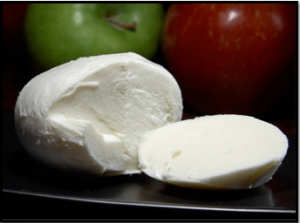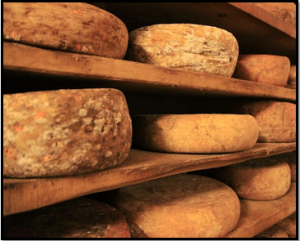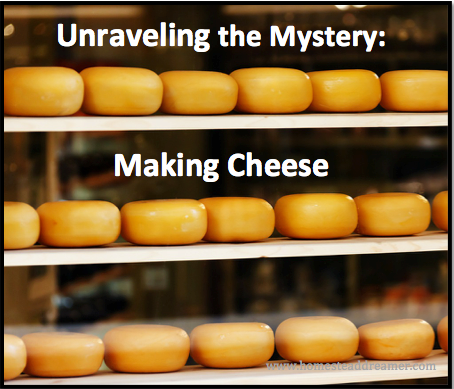CHEESE!! Both Mister Dreamer and I absolutely love cheese, all different kinds. I have written before about this wonderful food that can be stored for a longer time than most foods. It is one of the few ways we can ‘preserve’ dairy. As many of the long time followers know, we love to smoke cheeses for special treats but making our own the first time was a disaster. Of course, we tried to make it by using powdered milk (not instant!). While it was edible, it was less than appetizing.
Moving forward! I want to understand and practice making different kinds of cheeses because it is a good skill to have and if I can make it myself (while saving money) well why not?! As with all of our “Unraveling the Mystery” articles, we will look at the science side of cheese making, the equipment and process for making cheese, and then include links to tried and true recipes!
The Science of Making Cheese
Cheese is made by a fermentation process that pulls the proteins out and makes them curdle (going to curd). Please keep in mind that explaining the actual “science” of the chemical reactions and how they differ from one process or method to another would turn this article into a book. Personally, I just want to know how it works and get to it (likely you do, too), so I will give you the short and skinny of it.
- Enzymes are added to unpasteurized, preferably whole milk (not to be confused with homogenized milk) that separates the curds (proteins, fats, etc) from the whey.
- The kind of cheese you get depends on if you are using an acid for coagulation (vinegar, lemon juice, etc) or rennet.
- If you would like to really get into the ‘hows and whys’ of cheese making, here is a link to fill in the blanks.
The Equipment and the Process
The overall process for making most cheese is the same. The reason we have so many different kinds is because a slight variation when making “the wine of food” can ultimately change everything and give you a completely different result! Since I am not trying to write a novel (get to making cheese already!), I will cover the most basic cheese to make at home which is acid cultured versus using rennet. A soft cheese is easier and faster to make and eat than harder cheeses that require aging.
The Equipment
 You really don’t need much to make cheese with. The average household would likely only need to buy one or two things (other than the milk, of course). Here are the items you need to have at hand.
You really don’t need much to make cheese with. The average household would likely only need to buy one or two things (other than the milk, of course). Here are the items you need to have at hand.
- A pot large enough to hold the amount of milk you plan on using. Heavy bottomed is better since it will help keep the milk from scortching.
- Milk. The higher the fat content, the more cheese you get. It is important not to use ultra-pasteurized milk. During that process, the proteins are broken down too much and won’t form curds very well.
- Thermometer, rated safe for cooking with.
- Strainer, preferably wire mesh
- Cheesecloth
- Kosher Salt (if desired)
- Lemon juice, vinegar, or rennet (see below for the differences)
The Process
Brace yourself. You may be blown away by how easy this really is!
- Pour the milk into the pot
- Turn on the heat to a low medium. Too hot and you will scorch the milk! Better to take a little longer than go to quickly.
- Stay with your milk. You have to stir constantly and gently while the temp comes up!
- Once the heat is up to the temperature of your recipe (see below!), remove from the heat.
- Add your vinegar, lemon juice, or rennet and stir thoroughly and gently. You will know when it is working because curds will begin to form. It happens very suddenly. You will notice the curds separating from the whey.
- Let it sit for 5 minutes (or however long your recipe says).
- Check the curds with a knife. If they cut cleanly, chances are it is ready. For firmer cheese, let it sit longer.
- Ladle out the curds into a cheesecloth lined strainer. If saving the whey, do it over a bowl or jar.
- Depending on what kind of cheese you are making will determine what happens at this point. Mozzarella is stretched, cottage cheeses or paneer cheese is pressed, etc. Salt is usually added at this point and the cheese worked to achieve your desired texture, flavor, shape, etc.
That is pretty much it! The variety you make will also determine whether or not it can be (or should be) aged and preserved with cheese wax (not paraffin wax!). Some people will use weights to remove more of the whey from the cheese (makes it firmer).
Rennet vs Vinegar or Lemon Juice
What is rennet? Well, before science stepped in, the only way you could get rennet was from the stomach of animals. It is an enzyme. While it does not sound appealing, the results sure are! Thanks to science, there are options! You can get regular animal rennet or vegetable rennet in either liquid or tablet form. The type of cheese you want to make determines which kind of acid or enzyme you will need. Harder cheeses like cheddar require rennet while softer cheese such as mozzarella uses vinegar or lemon juice to curd the milk.
Lemon juice is reported to give a bit of a tang to the cheese while vinegar tends to be more of a neutral flavor.
What to do with the Whey?
Whey is reportedly very tasty with many health benefits. You can use it to soak grains in, in breadmaking, make ricotta, and all sorts of other goodies. Livestock and domestic animals love it too but be careful with Fido and Whiskers – too much can make them sick up. A quick Google search will give you lists and lists of what you can do with the whey leftover.
Aging and Preserving Cheese
 Soft or ‘quick’ cheeses usually aren’t aged more than a few hours or days and normally aren’t stored for the long term. That is not to say you can’t, it just isn’t normally done. Hard cheeses like cheddar are different.
Soft or ‘quick’ cheeses usually aren’t aged more than a few hours or days and normally aren’t stored for the long term. That is not to say you can’t, it just isn’t normally done. Hard cheeses like cheddar are different.
Aging the cheese gives unique flavors and allows all those little microbes and enzymes work their magic on the proteins. Aging cheese is not something you just tuck away and forget about it. The area needs to be checked on and the climate controlled. If you want to get more serious about aging cheeses, I highly recommend you do research into the type of climate that is best for the type of cheese you are making. Better to figure out that you have no suitable place to age your hard work before actually making batches of cheese.
Cheese can be preserved with the traditional wax (but not paraffin!), though many are using vacuum sealers instead because there is less mold issue.
The Fun Stuff
Though we have zero access to fresh milk, using whole milk is good enough to work with when making your cheeses and personally, I really look forward to experimenting! We have done the mozzarella and I helped a friend make paneer cheese. Let me tell you straight out – it is hard to stop eating fresh cheese once you have started. I have enjoyed ‘squeaky cheese’ curds that were smoked (oh yes, we WILL be doing that ourselves too) or made with fresh spices like basil and oregano. There is no comparison.
Some people would prefer to just get a kit and I don’t blame them! Especially for the newbie, it helps boost confidence when you have everything right there at hand. Here is a list of kits on Amazon (filtered for 4 star plus and Prime eligible, of course!).
Below you will find links for some quick and easy, at home cheese making recipes. Tried and true
LINKS:
Self Reliant School – World’s Easiest Cheese
Better Hens and Gardens – French Style Cream Cheese
Chickadee Homestead – Homemade Cream Cheese
Homestead Lady – How to Make Feta Cheese
Melissa K Norris – How to Make Homemade Mozzarella
Serious Eats – Paneer (or Queso Fresco) Cheese Recipe
Trayer Wilderness – How to Make Simple & Tasty Goat’s Milk Cheese
One Ash Farm – Raw Milk Soft Cheese
Back to Our Roots – Homemade Feta Cheese




